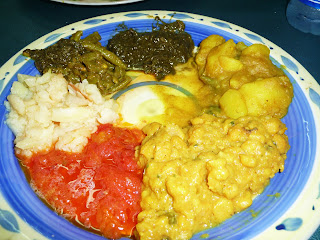Monday, October 18, 2010
Friday, June 25, 2010
Caribbean life
Sunday, June 20, 2010
Doubles

Doubles are like the bagels and cream cheese, the muffins, or the doughnuts of Trinidad. Sprinkled throughout the country, you’ll see the umbrellas, coolers, and lines of people holding their hands close to their mouths eating doubles. For 4$TT, you get two circles (thus the doubles) of barra (fried, flat dough) with a curry channa (garbanzo beans) on top. Toppings vary: the sweetest come with mango and tamarind, the freshest come with chunks of cucumber and shado-beni, and the spiciest come doused with pepper sauce. The most experienced vendors flip the ingredients from multiple containers onto the dough with Olympic efficiency and accuracy. Doubles only ever come plural; don’t make the mistake of ordering a double…people will stare. The idea is to find the vendor whose doubles matches your doubles dream and then visit them religiously. Tom, not a religious man before moving to Trinidad, has vowed to eat doubles every day of his last week here.
Beyond sustenance and spice, doubles supply conversation and competition. People compare and contrast vendors for hours, and the more detailed and opinionated you are in these conversations, the more respect you earn. Aaron does all right since he and Tom travel vast distances on the pot-holed Trini roads to sample doubles around the island. He can wax well about the 7 PM Valsyn guy, the 3 PM lady by the big tree in Diego Martin, George’s on Ariapita, George’s Ex, D&A, the DDI family, the UWI stand, and then the multitude of vendors in Tunapuna, but the airport stand gets his top vote. Bringing coworkers, family and friends, or students doubles in the morning earns you days of appreciation.

Roti Roti Roti

Roti. I know I’ve described it before, but let me do it better. First, let me say that it’s delicious and eating one usually means you can skip dinner.
There’s a variety of vegetables: bodi (long, green beans that appear in the grocery store wrapped into twisted bundles, but are cooked down in dishes until they are soft), pumpkin (mounds of soft, sweet orange), potato (bite-size chunks in a yellow, cloudy liquid, with lentils mixed in), greens (spicy, bitter, and almost black), mango (often with thick slices of the pit and/or skin included), and sometimes tomato (salty and shiny with oil).
Eating roti doesn’t fit into the American definition of convenience; you couldn’t eat it while driving because sometimes you have to pull the chicken bones or mango pit out of your mouth. (This takes practice, and usually seems like something you should be doing alone, like flossing, but here it’s no big deal.) Instead, this meal takes time and care so you can slow down and enjoy the company around you. There’s a fast food version, sold at The Hot Shoppe, which will do for a fix, but the best roti is made from experts. Sometimes they’re found in St. James with a cart that holds the necessary five to six silver, tightly lidded secretive pots, sometimes they’re found inside small, warm restaurants with two tables, and sometimes found in friend’s auntie’s homes, where the smells come out and greets you on the porch.

On the street, when you pay, you lay your money down and take your change, but the vendors aren’t far.


















